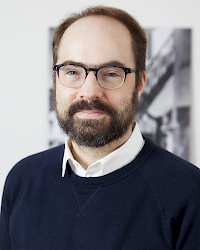Vita
Colin Lang is a critic and art historian whose research focuses on the history of electronic music and its relationship to the plastic arts. He is currently at work on a manuscript that traces the development of electronic music as it emerged in, and out of, more traditional artistic contexts (galleries/museums, theater) beginning in the 1960s.
Assistant Professor, Virginia Commonwealth University, 2011-Present
Lecturer, Princeton University, 2010-2011
PhD, Yale University, 2010
Dated from 2018
Fields of research
Contemporary art and theory; sonic practices in the arts; media history and theory
IKKM Research Project
From the Studio to the Stage: The Indexical Predicament of Live Electronics
From its inception, the propagation of electronically generated music was hampered by the sheer magnitude and complexity of the devices employed to realize its first works, leading one of its earliest inventors and theorists, Herbert Eimert, to conjecture that any attempt to realize this new electronic music with instruments would be "doomed to failure." What Eimert could not have predicted was the invention of new kinds of instruments—portable voltage-controlled synthesizers, specifically—beginning in the 1960s that were designed with two primary goals in mind: to construct a single device that could approximate the range of frequencies and tones previously only available in the studio environment for a commercial audience, and to enable live performance. What kind of operations followed, then, from this new technology, and how did the language of musical performance transform under the rubric of live electronics? Moreover, how could one “show” this electronic music, point in tangible ways to its causes, or the sources of its utterances? Does electrically generated sound herald a new regime of indexicality that finally does away with deixis, and in its place, sets forth a circuit of pointing and gesturing surfaces that leads only back to, and out towards, the mysterious sounds generated by machines and not the flesh and blood performers themselves? Discrete historical moments in the history of live electronic music, beginning in Rome with the American expat composer ensemble Musica Elettronica Viva and then moving to West Berlin and Düsseldorf, will be investigated with these questions in mind.
Recent publications
“Celluloid Drag, Sonic Disguise: Katharina Sieverding, Kraftwerk, & Glam.” The Art Bulletin (March 2017)
“From the Organism to the Organic: Beuys’ Plastik in Light of Goethe,” in Beuys, le dernier Romantique?, ed. A. Kramer-Mallordy & C. David
“A Subtle Art of Participation.” In Ralph Coburn: Random Sequence, exh. cat. (Chicago: Arts Club of Chicago, 2017).
“From Measurement to Memory: On the History and Future of Imi Knoebel’s Raum 19,” in Imi Knoebel. Kernstücke, ed. M. Hentschel (Kunstmuseen Krefeld, 2015), 137-143.
